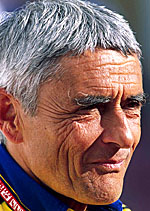 The 56th Formula One world championship marks the dawn of a new era. The FIA, motor sport's governing body, has drafted a series of revised regulations in a bid to cut both running costs and cornering speeds. Although mid-race refuelling stops will still be permitted, drivers will no longer be allowed to make tactical tyre changes – they will obliged to use the same set for qualifying and the full grand prix distance.
The 56th Formula One world championship marks the dawn of a new era. The FIA, motor sport's governing body, has drafted a series of revised regulations in a bid to cut both running costs and cornering speeds. Although mid-race refuelling stops will still be permitted, drivers will no longer be allowed to make tactical tyre changes – they will obliged to use the same set for qualifying and the full grand prix distance.
Here, Michelin's motorsport director Pierre Dupasquier assesses the likely impact of the latest tyre rules.
Do you support the tyre proposals that have been accepted for 2005?
Pierre Dupasquier: "Michelin is absolutely behind the concept of a tyre that lasts for a whole race – it was our suggestion in the first place that we proposed in 2004 ! It saves money, because teams get through fewer sets during a race weekend, and it helps the FIA's campaign to reduce cornering speeds because we will obliged to use firmer tyre constructions for the sake of durability, and this new tyre constructions will reduce the speed."
This isn't completely unknown territory for Michelin, is it?
PD: "Completing a grand prix distance on a single set of tyres is nothing new. It was a matter of routine during most of our first stint in F1, between 1977 and 1984. Henceforth teams and drivers have to adapt their chassis, aerodynamic and suspension set-ups to strike the best balance between performance and tyre durability. We have looked back at some of the things we did during the 1970s and early 1980s, but you have to remember that technology has changed beyond measure since then. Cars also started on full fuel loads for most of that period and, of course, we are now working with grooved rubber rather than slicks. Those are the biggest differences."
Will the latest rules bring any new factors into play?
PD: "I believe they will put an added onus on the drivers – we might see considerable performance fluctuations, even within the same team. Different set-ups and contrasting driving styles can have a significant effect on tyre-wear rates.
"Teams and drivers need to work out how best to look after the tyres and capitalise fully on their potential. Towards the end of a grand prix, some drivers – those who don't adapt their driving style to counter a little bit of understeer, for instance – might find their tyres begin to deteriorate with 10 or more laps still to run, yet a rival with identical equipment might make it all the way to the chequered flag with plenty of life left in their tyres. That's the difference a little bit of finesse could make.
"Traction control will be critical, too. If a system generates too much wheelspin through being incorrectly programmed, it could ruin a set of tyres by mid-race."
What are the biggest potential headaches for a tyre manufacturer?
PD: "We don't yet know how temperature fluctuations and different track layouts might affect the latest compounds. People talk blithely about the new-generation tyres being ‘hard', because they equate that with durability, but reality is not that simple. By nature, harder tyres last longer but they don't generate a high level of grip. That causes a car to slide around, which accelerates tyre wear. It's a vicious circle. That said, you have to be careful not to manufacture too soft a compound, which might limit the degree to which a car slides but won't necessarily stand up to a full grand prix distance. You have to find a compromise between these two extremes. We are embarking on a voyage of discovery."
How did the drivers react after getting to grips with the latest rubber?
PD: "Naturally, the general feeling was that cars slide around more – but that is mostly a product of the new aerodynamic regulations, which have reduced downforce. Whenever a driver has conducted a race simulation test, stringing together dozens of laps without changing tyres, they begin to get a feel for how the car might handle during the closing stages of a grand prix. For tyre suppliers, there is a risk that drivers and engineers will have an inclination to blame their tyres for any performance drop- off as a race nears its conclusion. But, as I have already indicated, the key thing is to devise a set-up that allows a set of tyres to last a full race distance. Clearly, some teams and drivers will manage this better than others – even if they are running identical compounds."

 The 56th Formula One world championship marks the dawn of a new era. The FIA, motor sport's governing body, has drafted a series of revised regulations in a bid to cut both running costs and cornering speeds. Although mid-race refuelling stops will still be permitted, drivers will no longer be allowed to make tactical tyre changes – they will obliged to use the same set for qualifying and the full grand prix distance.
The 56th Formula One world championship marks the dawn of a new era. The FIA, motor sport's governing body, has drafted a series of revised regulations in a bid to cut both running costs and cornering speeds. Although mid-race refuelling stops will still be permitted, drivers will no longer be allowed to make tactical tyre changes – they will obliged to use the same set for qualifying and the full grand prix distance. 



















sign in